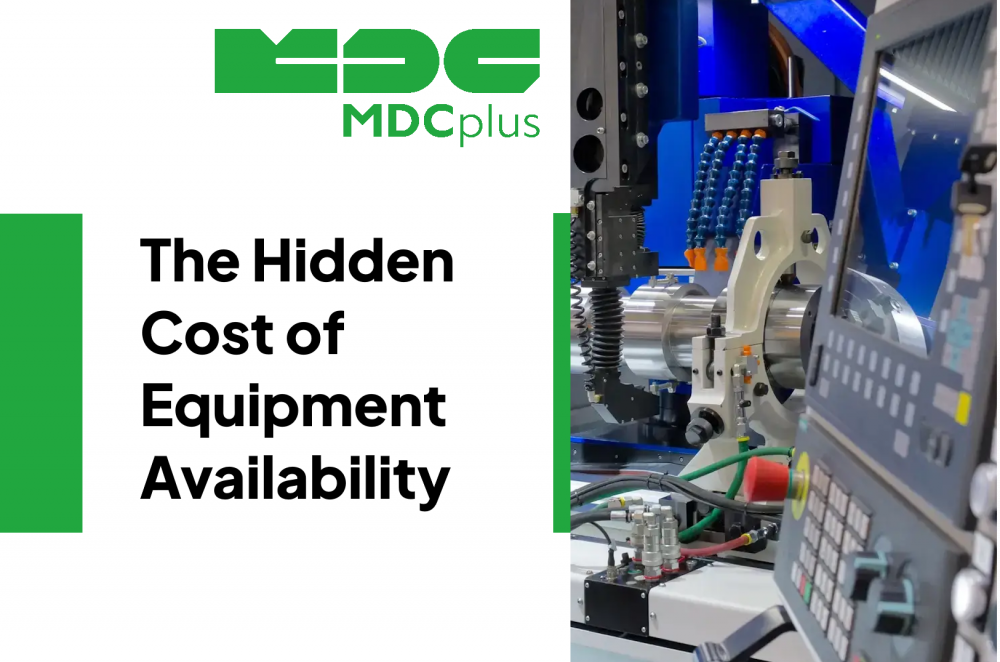The Hidden Cost of Downtime: Why Equipment Availability Deserves Your Attention
What Is Equipment Availability?
In a typical machine shop, every hour matters. From quoting to setup, from first cut to final part, manufacturers are in a constant battle against time. But not all time is created equal - and some of the most expensive hours are the ones when nothing at all is happening.
Unplanned downtime has a way of slipping under the radar. It hides in shift changes, extended setups, delayed tool changes, or simply in moments when no one’s watching the clock. Ask most operators or managers how much their machines are actually available - that is, actively cutting parts during scheduled time - and the answer is usually optimistic. “Probably 85 to 90 percent,” they’ll say. But when those numbers are put to the test, the reality is often lower. Sometimes, significantly lower.
This is where the concept of equipment availability comes in.
What Is Equipment Availability?
In the simplest terms, equipment availability is the percentage of scheduled time a machine is actually running. If a CNC lathe is booked for a 40-hour week but only spends 30 hours producing parts, its availability is 75 percent. The other 25 percent - whether due to unplanned downtime, slow setups, or waiting on material - is lost production time.
For manufacturers running tight schedules or thin margins, that kind of gap isn’t just a performance issue. It’s a financial liability.
Why It Matters - Especially in Precision Manufacturing
CNC machines are built to run. Every hour they sit idle during scheduled time represents not just lost output, but wasted capacity. The impact is greater than many assume. In high-mix or just-in-time environments, one unplanned delay can cause a cascade of rescheduling, overtime, or late delivery penalties.
Industry data suggests that unplanned downtime on CNC assets can cost two to four times more than on non-critical equipment. That’s because the downstream consequences - missed customer deadlines, overtime labor, delayed shipments - quickly compound. If a shop charges $100 an hour per machine, losing just one unscheduled hour per day across 10 machines adds up to over $250,000 a year. And in many cases, it’s closer to $300,000 when you include the ripple effects.
The good news is: this loss is preventable. But first, you need to measure it.
Where to Start: Measuring What You Don’t Yet See
You don’t need a fully automated smart factory to start tracking availability. The first step is often the simplest - begin with visibility. Whether by using a whiteboard, a spreadsheet, or a basic log, start recording the planned operating hours for a machine and the actual number of hours it runs.
For shops with connected equipment, machine-level data can be gathered directly through PLCs or software that logs run time, stop time, and idle states. Some solutions can be installed with no downtime, providing live dashboards or daily reports on availability. And while perfection isn’t the goal on day one, even the first week of real data is often eye-opening.
One automotive parts supplier connected a set of 18 CNC machines and discovered their assumed availability of 85 percent was actually closer to 71 percent. That 14-point gap represented nearly $270,000 in unrealized production capacity annually. And these weren’t outdated machines - they were in good condition, running skilled jobs. But no one had noticed the creeping inefficiencies in setup times, operator shifts, and material handling between runs.
What Changed When They Saw the Numbers
After six weeks of focused tracking, minor procedural adjustments led to major changes. Availability increased from 71 to 85 percent. Unplanned downtime dropped by nearly half. No new machines were purchased. No staff was added. Simply by making the current assets more visible and accountable, the plant recovered over $130,000 per year in production value.
This is not an isolated case. In most shops, the first step toward improvement is simply knowing where the time goes.
What You Can Learn by Looking Closer
Manufacturers pride themselves on precision, yet many operate without precise data about how their machines perform over time. They estimate. They guess. But when availability is tracked directly - without filters or assumptions - the conversation changes.
That’s not just about cost savings. It’s about better scheduling, more accurate quoting, and a stronger case for or against capital investment. Before buying a new machine, ask: are you using the ones you have to their full potential?
Some shops discover consistent downtime patterns linked to shift changes or late material delivery. Others find that setup time is longer than expected - not because of complexity, but because tooling isn’t prepped in time. These are not complex problems to solve. But they only show up when the data is honest.
The Bottom Line
Availability is a clear, measurable way to understand whether your machines are truly working for you - or waiting. And in today’s competitive manufacturing landscape, that difference matters.
You don’t need a high-tech overhaul to get started. A week of manual tracking or a plug-and-play monitoring tool is often enough to uncover hours - and dollars - you didn’t know you were losing.
So ask yourself: how much more productive could your shop be if you really knew when your machines were running?
And more importantly - how much are you losing by not knowing?
About MDCplus
Our key features are real-time machine monitoring for swift issue resolution, power consumption tracking to promote sustainability, computerized maintenance management to reduce downtime, and vibration diagnostics for predictive maintenance. MDCplus's solutions are tailored for diverse industries, including aerospace, automotive, precision machining, and heavy industry. By delivering actionable insights and fostering seamless integration, we empower manufacturers to boost Overall Equipment Effectiveness (OEE), reduce operational costs, and achieve sustainable growth along with future planning.
Ready to increase your OEE, get clearer vision of your shop floor, and predict sustainably?
